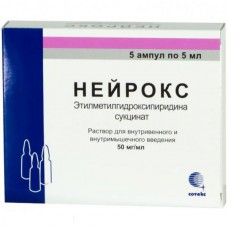Expiration date: 10/2026
Description of dosage form:
Colorless or slightly yellowish transparent liquid
Pharmacokinetics:
When the/m drug is determined in the blood plasma for 4 hours after administration. Tmax in/m introduction-0, 3-0, 58 no. Cmax in/m administration at a dose of 400-500 mg-2, 5-4 µg / ml. Ethylmethylhydroxypyridine succinate quickly passes from the bloodstream to organs and tissues and quickly eliminated from the body. The average time of retention of the drug in the body when the/m introduction — 0, 7-1, 3 hours Metabolized in the liver by glukuronirovania. Quickly excreted in the urine mainly in the form of metabolites (50% for 12 h) and in small amounts — unchanged (0, 3% for 12 h). The most intensively displayed during the first 4 hours after taking the drug. Urinary excretion rates of the unchanged drug and metabolites have significant individual variability.
Description of pharmacological action:
Ethylmethylhydroxypyridine succinate is an inhibitor of free radical processes, membraneprotective, possessing antihypoxic, stressprotectivna, nootropic, anticonvulsant and anxiolytic action. It belongs to the class of 3-hydroxypyridines. The mechanism of action is due to antioxidant and membrane-protective properties. Suppresses lipid peroxidation, increases the activity of superoxide dismutase, increases the ratio of lipid-protein, improves the structure and function of the cell membrane. Modulates the activity of membrane-bound enzymes, receptor complexes, which contributes to their binding to ligands, preservation of structural and functional organization of biomembranes and neurotransmitter transport, improving synaptic transmission. Increases the concentration of dopamine in the brain. It enhances the compensatory activation of aerobic glycolysis and reduces the degree of inhibition of oxidative processes in the Krebs cycle under hypoxia with an increase in the level of adenosine triphosphate and creatine phosphate, activates the energy-synthesizing function of mitochondria. Increases the body's resistance to the effects of various damaging factors in pathological conditions (shock, hypoxia and ischemia, cerebral circulation, ethanol intoxication and antipsychotic drugs). Improves metabolism and blood supply to the brain, microcirculation and rheological properties of blood, reduces platelet aggregation. Stabilizes the membranes of blood cells (red blood cells and platelets), reducing the likelihood of hemolysis. It has a hypolipidemic effect, reduces the content of total cholesterol and LDL.
Normalizes metabolic processes in ischemic myocardium, reduces the necrosis zone, restores and / or improves electrical activity and myocardial contractility, as well as increases coronary blood flow in the ischemic area, increases antianginal activity of nitropreparations, reduces the consequences of reperfusion syndrome in acute coronary insufficiency.
Stress-protective effect is manifested in the normalization of post-stress behavior, somatovegetative disorders, restoration of sleep-wakefulness cycles, impaired learning and memory processes, reduction of dystrophic changes in various structures of the brain.
Ethylmethylhydroxypyridine succinate has a pronounced antitoxic effect in withdrawal syndrome, eliminates neurological and neurotoxic manifestations of acute alcohol intoxication, corrects behavioral and cognitive disorders. Under the influence of Ethylmethylhydroxypyridine succinate increases the effect of tranquilizing, neuroleptic, antidepressant, hypnotic and anticonvulsant, which reduces their doses and reduce side effects.
Indications:
- acute cerebrovascular accident (as part of complex therapy)
- dyscirculatory encephalopathy
- neurocirculatory dystonia
- mild cognitive disorders of atherosclerotic origin
- anxiety States in neurotic and neurosis-like States
- withdrawal syndrome in alcoholism with a predominance of neurosis-like and vegetative-vascular disorders
- acute intoxication with antipsychotic drugs.
Contraindications:
- increased individual sensitivity to the drug
- acute renal failure
- acute hepatic failure
- pregnancy
- breast feeding
- childhood.
With caution-allergic diseases and reactions in history.
Side effect:
When parenteral (especially in/jet): dryness, metallic taste in the mouth, feelings of heat spilling throughout the body, sore throat and discomfort in the chest, a feeling of lack of air (usually associated with an excessively high rate of introduction and are short-term in nature).
With long-term use-nausea, flatulence, sleep disturbance (drowsiness or sleep disturbance).
Allergic reaction.
Drug interaction:
Enhances the action of benzodiazepine anxiolytics, antiepileptic (carbamazepine), antiparkinsonian (levodopa) drugs, nitrates. Reduces the toxic effects of ethanol.
Dosage and administration:
The/m and/in (struino or drip). When infusion method of administration of the drug should be diluted in 0, 9% sodium chloride solution.
Doses are selected individually. Begin treatment with a dose of 50-100 mg 1-3 times a day, gradually increasing it to obtain a therapeutic effect.
Struino Neurox is administered slowly for 5-7 minutes, drip-at a speed of 40-60 drops per minute. The maximum daily dose should not exceed 800 mg.
In acute violations of cerebral circulation, Neurox is used in complex therapy in the first 2-4 days — in/drip 200-300 mg once a day, then — in/m 100 mg 3 times a day. Duration of treatment - 10-14 days.
When dyscirculatory encephalopathy in the phase of decompensation of the Neurox should be administered in / in a jet or drip dose of 100 mg 2-3 times a day for 14 days. Then-in/m to 100 mg / day for the next 2 weeks.
For course prevention of dyscirculatory encephalopathy, the drug is administered in/m at a dose of 100 mg twice a day for 10-14 days.
In neurocirculatory dystonia, neurotic and neurosis-like States, the drug is administered in/m to 50-400 mg / day for 14 days.
In mild cognitive impairment in elderly patients and anxiety disorders, the drug is used in/m in a daily dose of 100-300 mg/day for 14-30 days.
With abstinent alcohol syndrome, Neurox is administered in / m at a dose of 100-200 mg/day or in / drip 1-2 times a day for 5-7 days.
In acute intoxication with antipsychotic drugs, the drug is administered in/in a dose of 50-300 mg/day for 7-14 days.
Overdose:
Symptoms: sleep disorders (insomnia, in some cases, drowsiness) with/in the introduction — a slight and short-term (up to 1, 5-2 h) increase in blood PRESSURE.
Treatment: as a rule, it is not required — the symptoms disappear on their own during the day. In severe cases, insomnia-nitrazepam 10 mg, oxazepam 10 mg or diazepam 5 mg. with excessive increase in AD-hypotensive drugs under the control of AD.
Special instruction:
During treatment, care must be taken when driving and engaging in other potentially dangerous activities that require concentration and speed of psychomotor reactions.
Neurox
(Ethylmethylhydroxypyridine
succinate)
- Brand: Sotex



